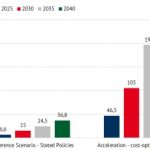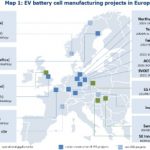Today’s solutions cannot give us a successful transition on their own. That’s why the innovations coming down the pipeline are so important. One way to measure what, and who, is innovating is to look at the number of patents being filed for low carbon energy (LCE), explains Sean Fleming writing for the World Economic Forum. He summarises the latest report from the European Patent Office and the IEA, “Patents and the energy transition: Global … [Read more...]
Fit for 55: Does squeeze on gas make coal exit harder? Event summary + video
On May 18, 2021, Energy Post hosted an expert panel with the European Commission, E3G, CERRE and PKEE (the Polish Electricity Association, who also sponsored the discussion). It looked at some of the key EU support mechanisms offered to countries/companies transitioning away from coal, including the EU ETS' Modernisation Fund, the Just Transition Fund and also how State Aid Guidelines (EEAG) contribute. We asked Stefaan Vergote (Senior Advisor … [Read more...]
EU’s new 15% emissions cut for EVs looks like 2% thanks to four “allowances”
EU regulations for reducing car emissions have been an important driver for getting European manufacturers to go electric and seek a leading position globally. But new rules will slow that progress, according to Transport & Environment (T&E). What look like rules that require a 15% reduction in CO₂ emissions from new cars from 2025 can mean a drop of as little as 2%, thanks to four “allowances”. Heavier average car weight (and electric … [Read more...]
18 energy transition scenarios to watch: where they agree and disagree
A wide range of regions, nations and respected organisations have created net-zero strategies and pathways, but on what do they agree and disagree? Dolf Gielen, Asami Miketa, Ricardo Gorini and Pablo Carvajal at IRENA have done a meta-analysis of 18 recent energy transition scenarios to find out. There is consensus over the main strategies: renewable power generation, and the direct and indirect electrification of end-use sectors – these account … [Read more...]
Sustainably harvested Forest Biomass can help replace coal and gas
Burning sustainably harvested wood pellets emits far less carbon than burning coal or gas. That’s the main reason why it should be used in the global energy transition, argues Jennifer Jenkins at Enviva. Coal is declining, but not fast enough. Gas consumption is rising. Forest biomass can more easily be swapped in than wind and solar to provide dispatchable power. But it must be done sustainably. Referencing her white paper, Jenkins sets out the … [Read more...]
Where to start building Hydrogen pipelines? Near industrial hubs for steel, ammonia, and plastics
Converting gas pipelines to carry hydrogen is going to be expensive. We don’t even know how much hydrogen we’ll really need in 2050, given electrification – the cheaper and preferred option to replace fossil fuels – will always be the first option. But we do know that certain industries like steel, ammonia, and plastics will always need hydrogen as a feedstock. Writing for WEF, Kevin Tu, Matthias Deutsch and Gniewomir Flis at Agora Energiewende … [Read more...]
EU-India cooperation: how to tap the large potential for climate action
India is the world’s fifth largest economy, the second most populous, and over the next few decades is expected to see energy demand grow more than any other country. Ritu Ahuja and Mekhala Sastry at TERI, Abhishek Kaushik at the Centre for Global Environment Research, and Alexandra Deprez and Lola Vallejo at IDDRI look at India’s challenges and which areas show the most potential for partnership with the EU. They focus on five themes: energy, … [Read more...]
Aviation should be given target dates for zero-emissions. It’s working for cars and trucks
The French government’s decision to ban some short-haul flights if there is a rail alternative under two and a half hours is only symbolic, says Andrew Murphy at T&E. It would reduce French aviation emissions by only 0.8%. Expanded to rail journeys under five hours and it’s still only 4.5%. Long-haul flying is the much bigger problem, but the resulting emissions are outside of France’s current climate target. Instead of just talking about … [Read more...]
German Hydrogen scenarios: 271 TWh of Green Hydrogen by 2040?
Germany is putting in place plans and legislation to launch its green hydrogen economy. Sila Akat and Simon Göss at Energy Brainpool look at the laws and regulations, existing and expected soon, that are driving this game-changing ambition. They have also created five scenarios (two are explained in detail here) for production, based on those plans. The reference “Stated Policies” scenario predicts an increase of electrolyser capacity to 5 GW by … [Read more...]
Coal exit: EU policy revisions must face both tech and socioeconomic obstacles
By 2030, the EU must cut its emissions by at least 55% compared to 1990 levels. Agreeing on the target was hard enough. Much harder will be agreeing on the design of the rules, regulations and financial support needed to achieve it. Pieter de Pous at E3G scopes out the major decline already experienced by coal - the worst emitting energy source - before looking at the challenges faced by heavy coal users in Central and Eastern Europe (CEE). The … [Read more...]
Green EV Batteries: tighter rules can advantage and boost manufacturing in Europe
Policies like the “green” labelling of EV batteries would give a significant advantage to European manufacturers, as well as accelerate the cleaning up of the supply chain. EU firms are better than most foreign battery manufacturers at monitoring and reducing emissions, writes Carole Mathieu at the IFRI Centre for Energy & Climate, referencing her report “Green Batteries: A Competitive Advantage for Europe’s Electric Vehicle Value Chain?” The … [Read more...]
“China and Europe – Energy Efficiency, the foundation of our net-zero future” [EVENT highlights and VIDEO]
We present the videos of the third of our three, 4-session workshops on the opportunities for European energy solutions providers to take part in China’s energy transition, held on April 13th and 14th 2021. In this workshop the theme was efficiency, with special reference to finance, buildings, heating and cooling, and smart solutions. Both regions need to go beyond the efficiency "easy wins" so we take a close look at what Europe can offer as … [Read more...]
Buildings Efficiency in China, and what EU partners should know
To set up our upcoming online event (April 13th & 14th) "China: Carbon Neutral by 2060 -EFFICIENCY FIRST” we look at how Buildings Efficiency is being tackled by Energy Management Contracting (EMC), when an ESCO (energy service company) provides energy retrofit services and gets paid for the future energy savings. The up-front investment cost is recouped over the multi-year lifetime of the service contract by taking a cut of the genuine … [Read more...]
The EU needs an independent science-led climate watchdog, a European Climate Change Council
Europe does not have the right institutional set-up for robust independent policy evaluation as the region enters a new, complex and radical stage of its energy and climate transition, argue Lola Vallejo (IDDRI), Alina Averchenkova (GRI), Matthias Duwe (Ecologic Institute) and Lara Lázaro Touza (Real Instituto Elcano). This month 12 expert advisory bodies in 11 EU Member States published a letter to EU policy-makers to launch an EU-level body, a … [Read more...]
Case studies: Strategic EV funding starts with an Essential Charging Network
Building a nationwide EV charging network is a daunting prospect. Camille Kadoch and Julia Hildermeier at RAP look at those places that are being strategic about it, starting with an essential network that will allay the concerns of consumers on the verge of buying an EV but put off by worries that they will get stuck somewhere with a flat battery. That’s frustrating, given the average American drives only 37 miles a day and Europeans 32 … [Read more...]
- « Previous Page
- 1
- …
- 12
- 13
- 14
- 15
- 16
- …
- 20
- Next Page »















